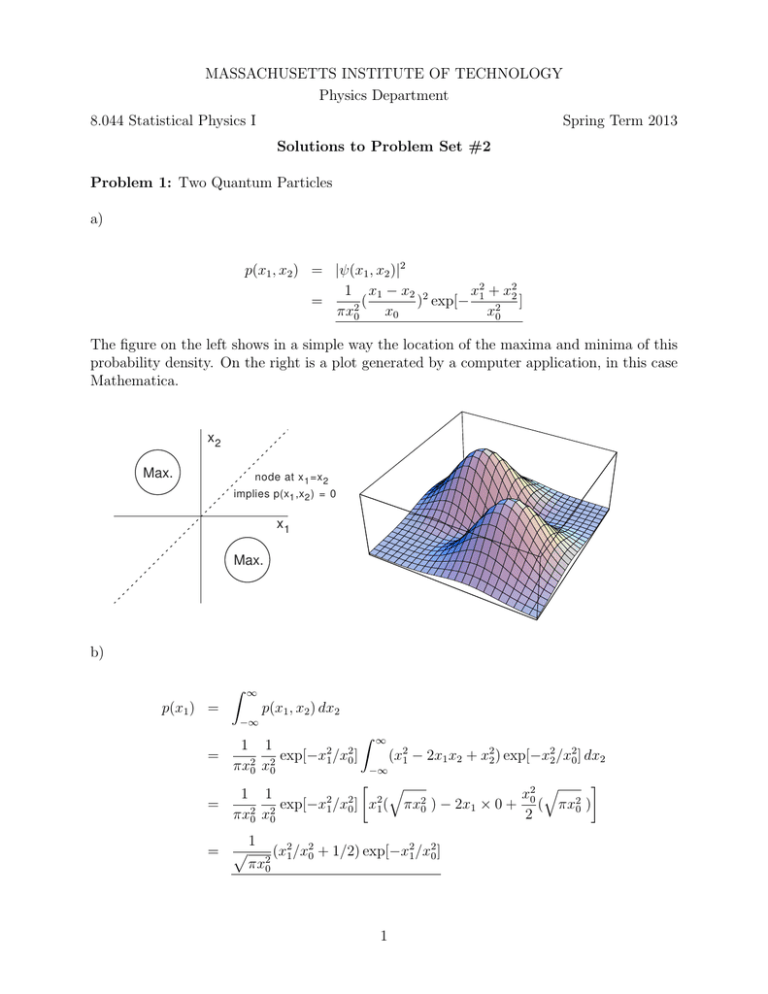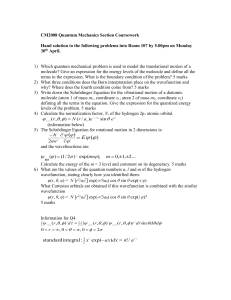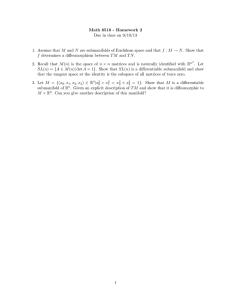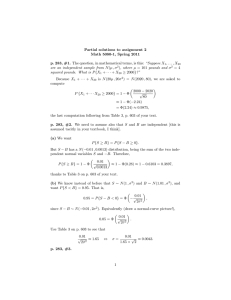MASSACHUSETTS INSTITUTE OF TECHNOLOGY Physics Department 8.044 Statistical Physics I Spring Term 2013
advertisement

MASSACHUSETTS INSTITUTE OF TECHNOLOGY
Physics Department
8.044 Statistical Physics I
Spring Term 2013
Solutions to Problem Set #2
Problem 1: Two Quantum Particles
a)
p(x1 , x2 ) = |ψ(x1 , x2 )|2
x21 + x22
1 x1 − x2 2
)
exp[
−
]
=
(
πx02
x0
x20
The figure on the left shows in a simple way the location of the maxima and minima of this
probability density. On the right is a plot generated by a computer application, in this case
Mathematica.
x2
Max.
node at x 1 =x 2
implies p(x 1 ,x2 ) = 0
x1
Max.
b)
Z
∞
p(x1 ) =
p(x1 , x2 ) dx2
−∞
1 1
=
exp[−x21 /x20 ]
πx20 x20
Z
∞
(x21 − 2x1 x2 + x22 ) exp[−x22 /x02 ] dx2
−∞
q
q
x20
1 1
2
2
2
2
2
=
exp[−x1 /x0 ] x1 ( πx0 ) − 2x1 × 0 + ( πx0 )
πx20 x20
2
= p
1
πx20
(x21 /x20 + 1/2) exp[−x21 /x20 ]
1
By symmetry, the result for p(x2 ) has the same functional form.
1
p(x2 ) = p 2 (x22 /x02 + 1/2) exp[−x22 /x20 ]
πx0
By inspection of these two results one sees that p(x1 , x2 ) 6= p(x1 )p(x2 ),
therefore x1 and x2 are not statistically independent .
c)
p(x1 |x2 ) = p(x1 , x2 )/p(x2 )
p
=
πx02 (x1 − x2 )2 exp[−(x21 + x22 )/x20 ]
exp[−x22 /x20 ]
πx02 (x22 + 12 x20 )
2
1
= p 2
πx0 (1 + 2(x2 /x0 )2 )
x1 − x2
x0
2
exp[−x21 /x20 ]
p(x 1 |x2 )
x1
0
=
x2
x1
It appears that these particles are anti-social: they avoid each other.
For those who have had some quantum mechanics, the ψ(x1 , x2 ) given here corresponds to
two non-interacting spinless1 Fermi particles (particles which obey Fermi-Dirac statistics) in
a harmonic oscillator potential. The ground and first excited single particle states are used
to construct the two-particle wavefunction. The wavefunction is antisymmetric in that it
changes sign when the two particles are exchanged: ψ(x2 , x1 ) = −ψ(x1 , x2 ). Note that this
antisymmetric property precludes putting both particles in the same single particle state,
for example both in the single particle ground state.
For spinless particles obeying Bose-Einstein statistics (Bosons) the wavefunction must be
symmetric under interchange of the two particles: ψ(x2 , x1 ) = ψ(x1 , x2 ). We can make such
a wavefunction by replacing the term x1 − x2 in the current wavefunction by x1 + x2 . Under
these circumstances p(x1 |x2 ) could be substantial near x1 = x2 .
1
Why spinless? If the particles have spin, there is a spin part to the wavefunction. Under these circumstances the spin part of the wavefunction could carry the antisymmetry (assuming that the spatial and spin
parts factor) and the spatial part of Fermionic wavefunction would have to be symmetric.
2
Problem 2: Pyramidal Density
y
a) The tricky part here is getting correct
limits on the integral that must be done to
eliminate y from the probability density.
It is clear that the integral must start at
y = 0, but one must also be careful to get
the correct upper limit. A simple sketch
such as that at the right is helpful.
1
y=1-x
1
Z
∞
p(x) =
1−x
Z
(1 − x − y) dy
p(x, y) dy = 6
−∞
0
1−x
1
= 6{ (1 − x)y − y 2
2
= 3(1 − x)2
x
0
1
} = 6{(1 − x)2 − (1 − x)2 }
2
0≤x≤1
b)
p(y |x) =
=
p(x, y)
6(1 − x − y)
=
p(x)
3(1 − x)2
2
(1 − x − y )
(1 − x)2
0≤y ≤1−x
Note that this is simply a linear function of y.
p(x)
p(y | x)
2
1-x
3
0
1
x
0
3
1-x
y
Problem 3: Stars
a) First consider the quantity p(no stars in a sphere of radius r). Since the stars are
distributed at random with a mean density ρ one can treat the problem as a Poisson
process in three dimensions with the mean number of stars in the volume V given by
< n >= ρV = 43 πρr3 . Thus
p(no stars in a sphere of radius r) = p(n = 0)
= exp[−4/3 πρr3 ]
Next consider the quantity p(at least one star in a shell between r and r + dr). When the
differential volume element involved is so small that the expected number of stars within it
is much less than one, this quantity can be replaced by p(exactly one star in a shell between
r and r + dr). Now the volume element is that of the shell and < n >= ρ∆V = 4πρr2 dr.
Thus
p(at least one star in a shell between r and r + dr) = p(n = 1)
1
< n >(1) e|−<n>
{z }
1!
|{z}
=
≈1
=1
≈ < n >= 4πρr2 dr
Now p(r) is defined as the probability density for the event “the first star occurs between r
and r + dr”. Since the positions of the stars are (in this model) statistically independent,
this can be written as the product of the two separate probabilities found above.
p(r)dr = p(no star out to r) × p(1 star between r and r + dr)
= 4πρr2 exp[−4/3 πρr3 ] dr
Dividing out the differential dr and being careful about the range of applicability leaves us
with
p(r) = 4πρr2 exp[−4/3 πρr3 ]
= 0
r≥0
r<0
p(r)
r
0
4
b) Now we want to find the probability density function for the acceleration random variable
a when a = GM/r2 , where r is the distance to a nearest neighbor star of mass M .
a(r)
GM/r 2
region of r for which
a < a0
a0
r
0
GM/a0
Z
P (a) =
∞
pr (r) dr
√
GM/a
dP (a)
1
p(a) =
=
da
2a
r
GM
pr
a
r
GM
a
!
Distant neighbors will produce small forces and accelerations, so their effect on p(a) will be
greatest when a is small. [For a different approach, see the notes on the last page of this
solution set.]
c) We use the pr (r) found in a):
pr (r) = 4πρ r2 e−4πρ r
to calculate
2πρ
p(a) =
GM
GM
a
5/2
3 /3
3/2
e−(4πρ/3)(GM/a)
p(a)
0
a
If there are binary stars and other complex units at close distances, these will have the
greatest effect when r is small or when a is large.
d) The model considered here assumes all neighbor stars have the same mass M . To improve
the model, one should consider a distribution of M values. One could even include the binary
stars and other complex units, from part (b), with a suitable distribution.
5
Problem 4: Kinetic Energies in an Ideal Gasses
In this problem the kinetic energy E is a function of three random variables (vx , vy , vz ) in
three dimensions, two random variables (vx , vy ) in two dimensions, and just one random
variable, vx , in one dimension.
a) In three dimensions
E = 12 (vx2 + vy2 + vz2 )
and the probability density for the three velocity random variables is
1
2
2
2
2
p(vx , vy , vz ) =
e−(vx +vy +vz )/2σ .
2
3/2
(2πσ )
Following our general procedure, we want first to calculate the cumulative probability function P (E), which is the probability that the kinetic energy will have a value which is less than
or equal to E. To find P (E) we need to integrate p(vx , vy , vz ) over all regions of (vx , vy , vz )
that correspond to 12 (vx2 + vy2 + vz2 ) ≤ E. That region in (vx , vy , vz ) space is just a sphere of
p
radius 2E/m centered at the origin.
The integral is most easily done in spherical polar coordinates where
v2
vx
vy
vz
dvx dvy dvz
=
=
=
=
=
vx2 + vy2 + vz2
v sin θ cos φ
v sin θ sin φ
v cos θ
v 2 dv sin θ dθ dφ
This gives
P (E) =
=
1
(2πσ 2 )3/2
4π
(2πσ 2 )3/2
Z
π
Z
sin θ dθ
0
Z √
Z √2E/m
2π
dφ
0
2E/m
v 2 e−v
v 2 e−v
2 /2σ 2
dv
0
2 /2σ 2
dv
0
Thus (substituting mσ 2 = kT )
dP (E)
2 1
p(E) =
=√
dE
π kT
r
E −E/kT
e
if E ≥ 0 (0 if E < 0)
kT
p(E)
3 dimensions
0
E
You can use this to calculate < E >= 32 kT . [For a different approach, see the notes on the
last page of this solution set.]
6
b) In two dimensions
E = 12 (vx2 + vy2 )
and the probability density for the two velocity random variables is
p(vx , vy ) =
1
2
2
2
e−(vx +vy )/2σ .
2
(2πσ )
To find P (E) we need to integrate p(vx , vy ) over all regions of (vx , vy )pthat correspond to
1
(vx2 + vy2 ) ≤ E. That region in (vx , vy ) space is just a circle of radius 2E/m centered at
2
the origin.
The integral is most easily done in polar coordinates where
v2
vx
vy
dvx dvy
=
=
=
=
vx2 + vy2
v cos θ
v sin θ
v dv dθ
This gives
1
P (E) =
2πσ 2
Z
Z √2E/m
2π
dθ
0
−v 2 /2σ 2
ve
0
1
dv = 2
σ
Z √2E/m
e−v
0
Thus (substituting mσ 2 = kT )
p(E) =
dP (E)
1 −E/kt
=
e
if E ≥ 0 (and 0 if E < 0)
dE
kT
p(E)
2 dimensions
0
E
You can use this to calculate < E >= kT .
7
2 /2σ 2
dv
c) In one dimension (not required)
E = 12 vx2
and the probability density for the single velocity random variable is
p(vx ) = √
1
2πσ 2
2
2
e−vx /2σ .
To find P (E) we need to integrate p(vx ) overpall regionsp
of vx that correspond to 12 vx2 ≤ E.
That region in vx space is just a line from − 2E/m to 2E/m.
Z √2E /m
v2
1
v e− 2σ2 dv
P (E) = √
√
2πσ 2 − 2E/m
Thus (substituting mσ 2 = kT )
p(E) =
dP (E)
1
=√
e−E/kt if E ≥ 0 (0 if E < 0)
dE
πkT E
p(E)
1 dimension
0
E
You can use this to calculate < E >= 12 kT .
8
Problem 5: Atomic Velocity Profile
v x(s)
A/s
region where
v x< η
η
s
0
A \ η2
In this problem we have two random variables related by s = A/vx2 . We are given ps (ζ) and
are to find p(vx ). To find the probability P (v) that vx ≤ v we must calculate the probability
that s ≥ A/v 2 . This is (the only possible values of vx are ≥ 0)
A3/2
√
P (vx ) =
σ 2 2πσ 2
Z
∞
A/v 2
1
ζ
e−A/(2σ
5/2
dP (vx )
A3/2
p(vx ) =
=− √
dvx
σ 2 2πσ 2
vx2
A
2 ζ)
dζ
5/2
2
e−vx /2σ
2
d A
2vx2
2
2
√
=
e−vx /2σ
2
dvx vx
σ 2 2πσ 2
p(v x)
0
vx
9
Problem 6: Planetary Nebulae
In this problem we are looking at matter distributed with equal probability over a spherical
shell of radius R. When we look at it from a distance it appears as a ring because we are
looking edgewise through the shell (and see much more matter) near the outer edge of the
shell. If we choose coordinates
so that the z axis points from the shell to us as observers
p
on the earth, then r⊥ = x2 + y 2 = R sin θ will be the radius of the ring that we observe.
The task for this problem is to find a probability distribution function p(r⊥ ) for the amount
of matter that seems to us to be in a ring of radius r⊥ . This is a function of the two
random variables θ and φ, which are the angular coordinates locating a point on the shell
of the planetary nebula. Since the nebulae are spherically symmetric shells, we know that
p(θ, φ) = (4π)−1 .
R
R
θ
r
r
line of sight view
section view through center
We want first to find P (r⊥ ), the probability that the perpendicular distance from the line
of sight is less than or equal to r⊥ . Since r⊥ = R sin θ, that is equal to the probability that
sin θ ≤ r⊥ /R as indicated in the figure above. This corresponds to the two polar patches on
the nebula: 0 ≤ θ ≤ sin−1 (r⊥ /R) in the “top” hemisphere and sin−1 (r⊥ /R) ≥ θ ≥ π in the
“bottom” hemisphere.
!
Z 2π
Z sin−1 (r⊥ /R)
Z π
q
1
2
P (r⊥ ) =
dφ
sin θ dθ +
sin θ dθ = 1 − 1 − r⊥
/R2
4π 0
0
sin−1 (r⊥ /R)
p(r⊥ ) =
dP (r⊥ )
r⊥
= p
for 0 ≤ r⊥ ≤ R (and 0 otherwise)
2
dr⊥
R R 2 − r⊥
p
2
Note: cos sin−1 (r⊥ /R) = 1 − r⊥
/R2 .
p(r )
0
1 r /R
10
[Insert for 3b]
Here, we have found the probability density with respect to the variable a (r) =
cumulative probability,
ˆ
P (a) =
pr (r) dr,
R={r: GM
≤a}
r2
GM
r2
by first considering the
where the integration region is over all values of r satisfying the inequality, and then taking taking the
derivative to get the density:
ˆ ∞
ˆ
dP (a)
GM
−
a
dr.
pa (a) ≡
=
p(r) dr =
p(r)δ
r2
da
−∞
=a}
∂R={r: GM
r2
If one is comfortable with considering densities with respect to different variables, it is quicker to relate the
densities directly using this last formula: the delta function just picks out the density with respect to a
whenever GM
r 2 = a. Here, the relation is monotonic, and so relating the densities is straight-forward, as the
P
delta just picks out a single value. Recalling δ (f (x)) = x: f (x)=0 |fδ(x)
0 (x)| , we have
ˆ
∞
GM
pa (a) =
pr (r)δ
− a dr
r2
−∞
q
ˆ ∞
δ r − GM
a
=
p(r)
dr
da(r)
−∞
=
=
dr
dr pr (r) √
da r= GM
a
52
3/2
2πρ GM
e−(4πρ/3)(GM/a)
GM
a
The two densities are just related by the Jacobian, as we would expect. The method can be used more
generally, when the relationships between variables can be one to many, and when we consider probability
distributions with more than one random variable.
[Insert for 4a]
Again, using the formula derived earlier relating the densities with respect to different variables, we can
directly write
ˆ ∞
1
2
pE (E) =
pv (v) δ
mv − E dv .
2
−∞
The delta function now picks out the two solutions of the equality, and we find immediately
!
!!
r
r
ˆ ∞
1
2E
2E
pE (E) =
pv (v)
δ v−
+δ v+
dv
m |v|
m
m
−∞
pv (v) pv (v) =
−
mv v=+√ 2E
mv v=−√ 2E
m
=
m
E
1
√
e− kT .
πkT E
11
MIT OpenCourseWare
http://ocw.mit.edu
8.044 Statistical Physics I
Spring 2013
For information about citing these materials or our Terms of Use, visit: http://ocw.mit.edu/terms.





